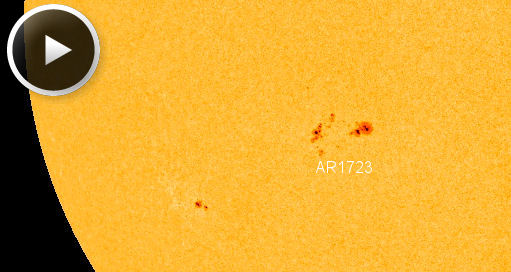DARK MATTER ON THE ISS: A particle detector on board the International Space Station has recorded intriguing signs of Dark Matter that could reveal what the mysterious substance is made of. If the finding holds up, it could lead to significant advances in cosmology. [full story] [video]
FAST-GROWING SUNSPOT: Two days ago, sunspot AR1723 did not exist. Now it sprawls nearly 100,000 km (8 Earth-diameters) across the sun's southern hemisphere. NASA's Solar Dynamics Observatory is monitoring the sunspot's rapid expansion:
AR1723 has a 'beta-gamma' magnetic field that harbors energy for M-class solar flares. If the magnetic field is changing as quickly as the underlying sunspot, it could become unstable and explode. Stay tuned for updates, as Earth would be in the line of fire. Solar flare alerts: text, voice.
CME IMPACT: A coronal mass ejection (CME) hit Earth's magnetic field on April 13th. The impact was not a strong one; geomagnetic activity never crossed storm thresholds. Nevertheless, the impact sparked faint auroras photographed in several northern-tier US states. Brian Larmay sends this exposure from Beecher, Wisconsin:
"I got up at 230 am CST to see if the auroras had made their way south, and I saw a glow that looked to he naked eye like light pollution," says Larmay. "My camera revealed the colors. I didn't expect much of a display because the CME impact was rather weak--but there it was."
"I have noticed that the southern hemisphere of the sun is starting to pepper more with spots," he continues. Indeed, the southern hemisphere has been lagging behind the north in sunspot production, and it might be starting to catch up. A surge in southern sunspot production would boost solar activity. "This is good news for the aurora chasers," Larmay opines, and he is right! Aurora alerts: text, voice.

![]()
Solar wind
speed: 377.7 km/sec
density: 0.9 protons/cm3
explanation | more data
Updated: Today at 1527 UT
![]()
X-ray Solar Flares
6-hr max: B5 1145 UT Apr16
24-hr: C1 0430 UT Apr16
explanation | more data
Updated: Today at: 1500 UT
![]()
![]()
![]()
Daily Sun: 16 Apr 13
![]()
![]()
Sunspot AR1723 has a 'beta-gamma' magnetic field that harbors energy for M-class solar flares. Credit: SDO/HMI
![]()
![]()
![]()
Sunspot number: 99
What is the sunspot number?
Updated 16 Apr 2013
Spotless Days
Current Stretch: 0 days
2013 total: 0 days (0%)
2012 total: 0 days (0%)
2011 total: 2 days (<1%)
2010 total: 51 days (14%)
2009 total: 260 days (71%)
Since 2004: 821 days
Typical Solar Min: 486 days
Update 16 Apr 2013
The Radio Sun
10.7 cm flux: 113 sfu
explanation | more data
Updated 16 Apr 2013
![]()
![]()
![]()
Current Auroral Oval:
![]()
Switch to: Europe, USA, New Zealand, Antarctica
Credit: NOAA/POES
![]()
![]()
![]()
Planetary K-index
Now: Kp= 0 quiet
24-hr max: Kp= 3 quiet
explanation | more data
![]()
Interplanetary Mag. Field
Btotal: 4.5 nT
Bz: 3.4 nT south
explanation | more data
Updated: Today at 1527 UT
![]()
![]()
![]()
Coronal Holes: 16 Apr 13
![]()
![]()
Solar wind flowing from this coronal hole could reach Earth on April 21-22. Credit: SDO/AIA.






